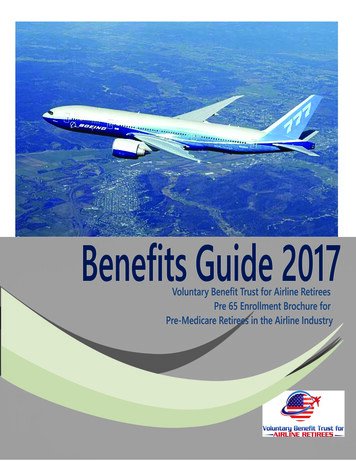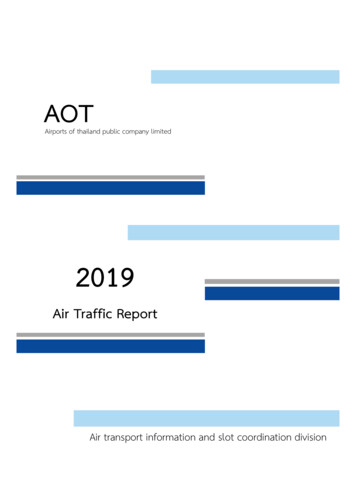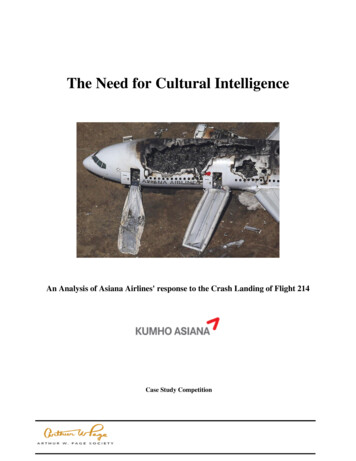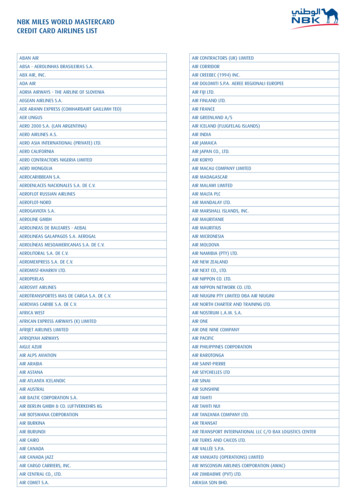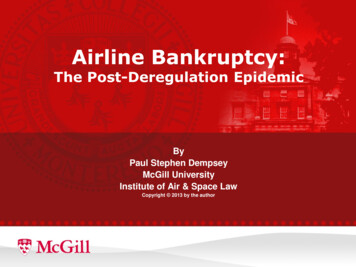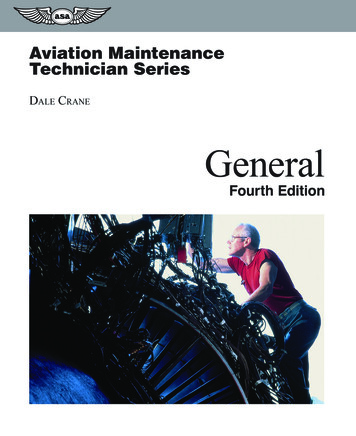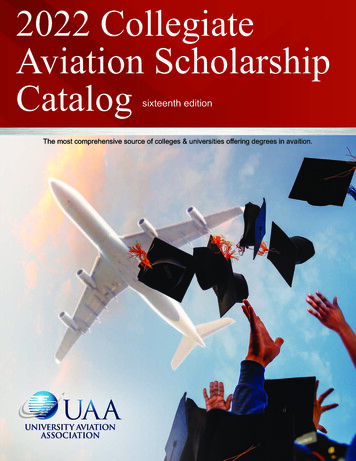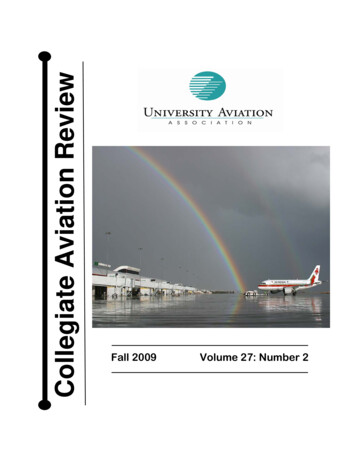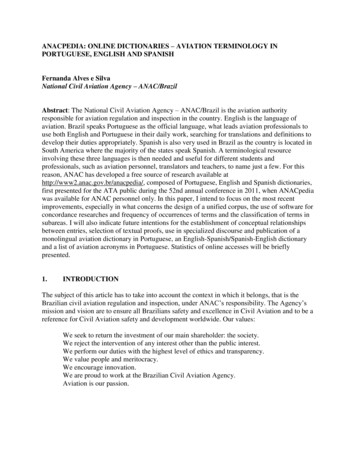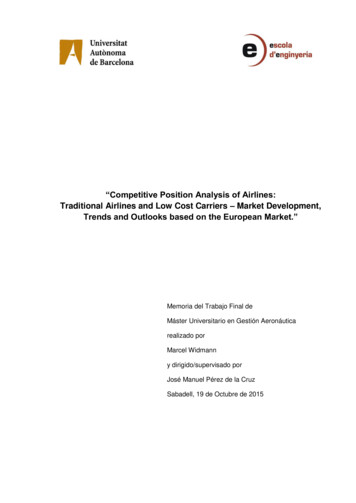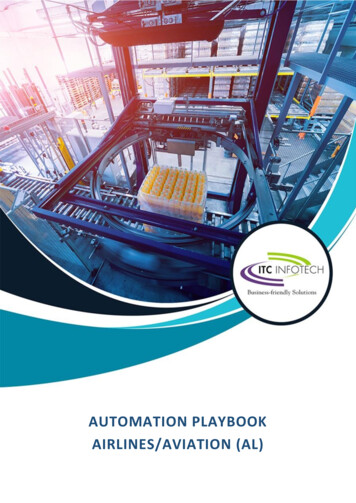
Transcription
AUTOMATION PLAYBOOKAIRLINES/AVIATION (AL)
A UTOMATION P LAYBOOK - ALTable of Contents1.2.3.4.5.6.P REFACE . 3C ONTEXT OF THIS DOCUMENT . 5T RENDS IN AIRLINES INDUSTRY AND RELEVANCE OF A UTOMATION . 5A UTOMATION ACROSS THE AIRLINES INDUSTRY VALUE CHAIN . 8C HALLENGES AND O PPORTUNITIES . 12I NTRODUCING P ROCESS DRIVEN A UTOMATION . 146.1.Process catalog . 166.2.Function wise Automation Propensity . 167.I NTRODUCING THE D IGITAL W ORKFORCE – PERSONA DRIVEN AUTOMATION . 187.1.Flight Analyst . Error! Bookmark not defined.7.2.Dispatch Planner . 207.3.H R Manager . 217.4.Finance Manager . 228.G ETTING S TARTED . 238.1.Approach to Automation . 238.2.Methodology . 238.3.Starter Kit . 259.10.C ONCLUSION . 28A PPENDIX . 30
A UTOMATION P LAYBOOK - AL1. P REFACEAutomation is in the air. It is the topic of animated discussion at every meeting, conference andseminar. As many as 90% of the world’s most influential companies—those in the Fortune 500—are investing aggressively in automation, creating bots for everyday tasks. Other organizationswant to emulate the leaders and are keen to move from experimentation to the application of botsat scale. The goal is to boost Customer Experience, Employee Experience and Product Experience.But bot adoption in the automation space remains low. On the other hand, research shows thatsavings from chatbots and intelligent virtual assistants will be US 8B by 2022. i Clearly,organizations are not going to continue to eye automation from a distance. Action is around thecorner. The question is: Where does one begin the automation journey?Let’s reframe that question: What can I do with automation that brings the highest ROI? Theanswer to that question provides a clue to where your automation journey should begin. In termsof how industry is applying automation, we see that 63% of the AIRLINES implementing automationhave done it to improve their finance function while 75% are using it to boost contact centerefficiency, HR, IT and Procurement processes. Within these functions, it boils down tounderstanding and solving problems to deliver efficiency, effectiveness and experience. We’d saythat automating those areas that impact customer experience should take precedence, followedby tasks that have high volume, are speed sensitive and have irregular labor demand.For many AIRLINES, automation has become a key component of their digital transformationinitiatives. It has become part of the social, mobile, data and analytics mix.However, the truth remains that many AIRLINES are struggling to adopt automation. One AIRLINESidentified 10 use cases that it wanted to automate. An examination of the 10 use cases showedthat only 6 were candidates for automation. However, those six processes could not be automated– for the simple reason that they were not templatized for use across the AIRLINES and needed tobe standardized first. There are two ways to look at this: The AIRLINES failed to adopt automation,or the AIRLINES learnt and is now better positioned to leverage automation.There are many reasons why automation has been slow in making its way into the technology mixof AIRLINES. It is important to understand why this is so. This document dives deep into theAIRLINES industry processes, challenges, and the potential areas for automation. This documentshould serve as a ready reckoner for the practitioners to understand where, and how to start theirautomation journey.Happy bots
A UTOMATION P LAYBOOK - ALThis page has been intentionally left blank
A UTOMATION P LAYBOOK - AL2. C ONTEXT OF THIS DOCUMENTThis document captures the core processes across the AIRLINES industry value chain and analyzesthe challenges faced and opportunities to improve through automation. The content of thisdocument is based on the latest trends demonstrated by different industry players, acrossgeographies and has been normalized to present an inclusive view.This document establishes an industry view of where automation can be leveraged to potentiallyimprove the performance and efficacy of the AIRLINES process. It is of relevance to the followingroles: Industry leaders (decision making capacity, influencers) looking to evaluate automation as ameans of boosting operational efficiency and human potentialSales and Business Development teams looking out to understand and set up preliminaryconversations to address client’s pain pointsOnboarding resources who are new into automation and industry knowledge3. T RENDS IN AIRLINES I NDUSTRY AND RELEVANCE OF A UTOMATIONThe AIRLINES industry being the most global of industries, is likely to see major impact and changesdue to externalities. Understanding the landscape in which the AIRLINES industry operates is thereforecritical for a sustainable future growth and greater connectivity. The passenger growth in AIRLINES travelis pegged at around 16% YoY and for good reasons. A new report published by IT provider SITA hasrevealed that “the demands of the growing number of tech-savvy travelers will have the biggest impacton the digital plans of airports and AIRLINES over the next six years”. By 2025, 68% of passengers willbe digital travelers. They will expect travel through airports to offer the same conveniences, controllingtheir experience digitally through their mobile devices, as every other aspect of their lives.As per International Air Transport Association report, the demand for air passenger services remainedsolid, with industry-wide revenue passenger kilometers (RPKs) increasing by 7.4% over the year 2019.Air passenger demand was supported by a generally solid global economic backdrop, especially earlierin the year, which in turn supporteds jobs, incomes and business activity, as well as the strongcompetition in the industry which helpeds ensure airfares remain affordable to travelers.Relevant to the passenger growth Operational cost was growing i.e. cost to serve per passenger; highvolume, but low margins constantly strives for innovative ways to reduce cost and increaseproductivity; RPA becomes an extremely critical technology to drive both these necessities.
A UTOMATION P LAYBOOK - ALAs per study of Top 5 Global AIRLINES: Ranked by Passenger TrafficMajor focus being on technology, the ask for technical skills is likely to increase which means greaterwage payouts for High Skilled Resources. Labor costs are expected to constitute roughly 25% - 30% ofthe AIRLINES’s operational cost in 2020. Labor/manpower now constitutes more than the fuel cost andhas been increasing.A recent McKinsey report shows that the need for physical and manual skills will decline significantly,while the need for technical skills will intensify.
A UTOMATION P LAYBOOK - ALThus, Automation will become an integral part to accelerate the shift in required workforce skills wehave seen over the past 15 years. The research finds that the strongest growth in demand will be fortechnological skills, the smallest category today, which will rise by 55 percent and by 2030 willrepresent 17 percent of hours worked, up from 11 percent in 2016. This surge will affect demand forin basic digital skills as well as advanced technological skills such as programming. Demand for socialand emotional skills such as leadership and managing others will rise by 24 percent, to 22 percent ofhours worked. Demand for higher cognitive skills will grow moderately overall, but will rise sharply forsome of these skills, especially creativity.As part of the automation, the focus is to deliver on all the three key aspects of efficiency, effectivenessand experience for the stakeholders through a digital workplace of the future.1. Efficiency - Automation for the key tasks across support functions (e.g. Finance, HR, Legal,Compliance etc.) result in direct labor-saving identified processes are usually labor intensiveand automation will deliver direct cost savings2. Effectiveness - Automation of broader spectrum of roles performed by the business in additionto the lower priority tasks for support functions that impact on quality improvement and costreduction across business functions3. Experience - Automation delivering a better experience by orchestrating the complex businessactivities and tasks through bots Improved work environment, high quality skills and higherproductivity add up in the businessWhile AIRLINES players based in the North America are majorly driving the sales globally, they are alsofacing stiff competition from emerging markets: -
A UTOMATION P LAYBOOK - ALNorth th ndustry/#airline-industry-trends4. A UTOMATION ACROSS THE AIRLINES INDUSTRY VALUE CHAINTechnology has empowered the digital customer today to change the rules of the Aviation businessand AIRLINES need to change the way they do business and become much more dynamic and agile.Business transformation is not new to any industry however we observe the need to draft a clearprocess heat map based on business priorities, complexity, ROI, frequency of task as some of thebasis for interconnecting and coming out with an Enterprise Business Model which can be used todrive the value chain in adopting & accommodating such transformations. Considering the pre andpost Covid way of doing business has changed the Aviation sector, customer priorities havesimultaneous evolved - their travel choices, curtailed travel plans, demand for digital interactionsand content, online transactions and near zero touch customer service are forcing enterprisesadopt new/re-configured business models and align processes to suite and adapt to the customerand business demands. These new ways of business operations requires Enterprises to have a clearview of departmental functions, roles, activities of interconnecting systems.SystemsRolesHR IT & AdminProductmanagementBusiness Planner,Alliance manager,Financial Planner,Procurement manager,Facility managerLegal counsellor,ITSM leaderBrand Manager,Product head,Development manager,Network planner,Business heads,Quality controlAnalytical tools,Visualization, Strategicplanning tools, HRMS,Collaboration tools,Finance managementsystem, ERP, ITSMWCM, CRM, PSS, RM , ERP,ACARS, Alliance network,Quality control tools, PMO,ESB, DWH, BI, ITSM, OEM Sales &ServiceSales Manager,CRM PlannerChannel managerMarketingmanagerFinancial controllerPricing plannerCustomer serviceAgentPSS, DCS, CRM,WCM, Pricing,Fares, Paymentgateway, GDS,OTA, ERP, E-com,ITSM, social mediaAirportServicesMaintenance& EnggOperationsF&L (Cargo)WFM LeaderFlight dispatcherAlliance managerLounge managerSecurity managerMaintenance planner,Engg. Leader,Hanger manager,Inventory planner,Quality controller,Stock and VendorAuditor,Fleet planner,Ground ops plannerGate manager,Airport office manager,Baggage manager,Customer servicemanagerLogistics Manager,Warehouse Manager,Ramp manager,Merchandise pickupand Receivingassociate WFM, CUTE, CUSS,ATC, Weather,ACARS, MRO, ERP,Crew roaster, PaxManifest, PSS, CRM,W&BMRO, Schedules, IROP,ERP, Payment gateway,OEMDCS, Bag manager,BRS, service desk,CUSS, CUTE, ERP,HRMS, World tracer,CMS, CPS, FPDS,FDMA, SQMS, ITMSFront Office tools,ITSM tools, Analyticaltools, PSS, W&B
MetricsActivitiesOutputsInputsA UTOMATION P LAYBOOK - ALHistoricaldemand/consumptionreports, Budgets,Existing contracts,Resourcerequirements,expenses, financialprojections, employeefeedbacks, customerfeedbacksBusiness & BCP plan,Forecasting, Rough cutcapacity plan, Capitalexpenditure plan,Annual Budget, Workforce plan,Procurement plan(IT/Non-IT), IT assetplan, Legal policyDemand plan, Productinformation, Historicalassortments, Consumptionreports, Consumerbehavior, Sales data,Budgets, IT landscape,vendor informationSales & availabilityrecords, Offeringsportfolio, PSS, Ecom, CVM, SVCSchedules, manifest,boarding information,SSR reports, ERP,HRMSSchedules, Supplierscorecard, Budgetapprovals, Workforceplans, HR plans, OEMSPOC, Parts inventoryFleet availability, Gateinformation, ATCcommunications,Airport security,Baggage informationLoad plan, cargomanifest,Marketing plan, IT Plans,resource plan, Productprocurement plan, Accountlevel sales, Network plan,certification plan, Quality &Audit plans, BusinessroadmapSales plan, CRMstrategy, Ancillaryproducts,Corporate targetplans, Channelperformance plans,Market expansionplanManpower Plan,schedule plans,Planeside serviceplan, Loungemanifest, Reporting,Check-in planMarketing planning, ITbudget planning, IT &Business Roadmap creation,Audits, Routes & Schedulesfinalization, New routes andcapacity decisions,Technology transformationinitiativesE-commerce, sales& ionplanning,campaignsSlot management,Task management,Baggage handling,Operationalperformance,Catering & LoungemanagementGate assignment plan,Fleet assignment, Crewbriefing plan androaster, Route plans,Customer handlingplan, reporting, groundtransport, Crewaccommodation pan,Transportationschedule.Gate assignments,Fleet assignment, Crewbriefing, bagmanagement,Customer complaintreporting, groundtransport, Crewaccommodation,accommodationAsset tracking,Outbound orders,Dispatch routing,Picking and packing,Loading, Warehousespace allocation,insurance plansBusiness Planning,Goal setting,Scheduling, ExecutiveS&OP, Auditing, Assetallocations, materialmanagement, HRsurveys & policies,Legal actions &resolutionsMRO schedule, IROPmitigation plan,Procurement SLAcontracts, Groupoperations, Turnaround services, nonscheduled services,Reporting, PO, Assetallocation, Hangermanagement planMRO scheduling, IROPplanning, ProcurementSLA monitoring, Groupoperations, Turnaround services, nonscheduled services,Reporting, PO, Assetallocation, Hangermonitoring.Goal achievement,Performance reports,Sales Comparison,Sales volume,StakeholdercommunicationCategory Sales, Productwise sales, Categorypenetration, New Itemsales, Growth in newmarkets, Cost reduction,Business transformationProduct wise sales,Categorypenetration, NewItem sales,Ancillary sales,increased PLF,reduced BELFCSAT score, optimalTAT, reduceddisruption, minimalincidents &complaintsReduced AOG,predictivemaintenance, all-timeavailability of parts,Timely boarding,minimal customercomplaints, Smoothpax flow, reduced lostbaggage, reducedmisconnectionESAT, CSAT,Compliance cost,Incident resolution,Arrest Leaks and faultypayoutsAsset tracking,Outbound orders,Dispatch routing,Picking and packing,Loading, Warehousespace allocation,insurance plansFig 1.3: AIRLINES INDUSTRY value chainTo keep up to the ever-evolving customer demand and business transformation, RPA becomes verycritical to be looked at across business functions. The need to constantly innovate for whichbandwidth is needed and secondly to support the low margins and high operating cost we need tolook at ways to reduce the Opex and RPA process to be a big area to tackle both. We have deviseda framework to draft the Automation roadmap for the industry considering the Personas of variousjob roles that not only automates the selected processes but also makes sure to effectively giveback maximum productive bandwidth associated with a particular Role. In order to do so we havealso put together a guiding grid to reflect the extent of automation against functional areas, thesecan be based on mutual discussion picked up to draft the roadmap of automation journey.
A UTOMATION P LAYBOOK - ALAutomation areas in the AIRLINES INDUSTRY value chain and KPIsExtent of AutomationHR IT & AdminAssetAllocationand TrackingMaterialManagementAuditingLowSales andOperationsPlanningMediumHR Surveys& PoliciesHighGoal SettingKey KPIs: Performance Report, Goal Achievement, Utilization, Sales ReportProductManagementMarketingPlanningIT BudgetPlanningRoutes andSchedulingNew Routeand y KPIs: Product wise sales, Penetration, Growth in new markets, RASK & CASKSales & ServiceSales tionPlanningCampaignManagementE-CommerceKey KPIs: Sales, BLF/PLF, Category Penetration, gementBaggageHandlingKey KPIs: CSAT Score, TAT, IROP, ent
A UTOMATION P LAYBOOK - ALExtent of AutomationMaintenance& Engg.MROSchedulingIROPPlanningProcurement, SLAMonitoringLowGroupOperationsMediumHighTurn ManagementKey KPIs: Asset Utilization, Productivity, Cost ustomerComplaintGroundTransportationKey KPIs: Customer Complaints, Hotel & Transportation Cost, Onboarding, Ground TimeF&L icking andPackingLoadingWarehouseSpaceAllocationKey KPIs: CSAT, ESAT, Compliance Cost, Arrest Leaks & Faulty PayoutsFig 1.4: Automation propensity map across AIRLINES INDUSTRY value chainIn conclusion, we can see that RPA can have a high impact on nearly 30% of the AIRLINES INDUSTRYprocesses, with broader benefits including better accuracy, faster throughput, higher straightthrough processing, improved tracking, reduction in cost, increased visibility and timely monitoringof processes/operations.We will now look at the challenges within the AIRLINES INDUSTRY, and the underlyingopportunities for RPA.
A UTOMATION P LAYBOOK - AL5. C HALLENGES AND O PPORTUNITIESFrom technology standpoint, Robotics and Automation are one of the key drivers of change for theAIRLINES Industry. Others being (and not limited to): Cybersecurity, VR/AR, IoT, New AircraftDesigns, etc. Automation is expected to lead to new opportunities, transforming how people anddevices are monitored and marketed to in real-time. Automation makes life easier, tasks faster andefficiency better. Some of the benefits that automation brings in are quality, cost reduction,improved turnaround time, consistency and operational efficiency.Robots increasingly work alongside people, taking on physical and repetitive tasks, with humansadding values in the spaces where AI have not yet become dominant. The below chart from SITA2019 Air Transport IT Insights suggest the need for Robotics and Automation in order to add valuein future AI space. In order to make 45% of R&D more effective, the dial of Major Program inRobotics and Automation needs to shift further towards the right.Fig 1.5 – SITA 2019 Air Transport IT Insights studyThere is a need to innovate. The AIRLINES industry has seen few fundamental challenges tobusiness models over the past 30 years, except for the arrival of LCCs and the introduction ofalliances. AIRLINES struggle to differentiate themselves, competing on network, pricing andservice. Profit margins are stressed and to top it, customer service, social values and simplicitybecomes increasingly important as consumers expect more personalized service. Data is floatingall around in the system (but in silos). Companies that can control the movement of data will haveextreme advantage over existing peers in developing new niches in these stressed environments.There is a potential for AIRLINES to take advantage of advances in automation to focus on customerservice and interactions with passengers. Hence, it is important to leverage existing strength (data,robotics and automation) to evolve in the industry.The rising volume in passenger travelling by air will impact the cost of services and IT expensesdirectly. This clubbed with rising competition and thin margins are a big concern for any AIRLINES.
A UTOMATION P LAYBOOK - ALAutomating some of the labor-intensive processes thus becomes key starting step. Some industrystatistics suggest that around 22% of the processes in the aviation industry can be either optimizedor eliminated which justifies our recommendations for process led and persona led automation.Fig 1.6 – Y-o-Y passenger volume iiAnother advantage of automation can be seen in relation to operating cost reduction. For instance,an efficient flight performance can reduce fuel consumption to achieve a lower operating cost andincrease profits. To make the flight performance more efficient and effective in order to squeezehigher profit margins, the data that gets generated in aircraft computer systems during a course ofa flight, needs to be consumed in order to study and further enhance the performance. Automatedprocesses and systems can help derive results faster as time to consumption of data gets e of the other opportunities automation brings into the landscape of the travel industryincludes business metrics reporting, responsiveness, expense management, customer retention,etc. Real time tracking and reporting through automation helps businesses identify trends of thebusiness. It also gives rise to the unforeseen business opportunities and helps in the overallgovernance of the operations. Time spent on admin tasks can be huge. But with automatedprocesses, the tasks can become fast. Through automation, high volume tasks can be carried out
A UTOMATION P LAYBOOK - ALwith greater accuracy while avoiding manual errors which in-turn leads to free up employees tofocus on other core business activities. With the help of automation, what was previously apainstaking task of inputting manual codes became a smooth painless effort. Employees can trackreal-time spending and access reports from a centralized location, which traditional systems couldnot handle. Automated self-booking systems have freed up time in other areas of business. Stacksof statements and invoices can now be swiftly processed even after modifications from thecustomer’s end. Conversations with the customers may not need to end after the journey iscomplete. Even post travel, businesses can stay in touch with the customers through emails andads in order to generate loyalty. AIRLINES can send campaigns with relevant offers based on thetravel history or even customers who browsed on the platform but did not check out can betargeted with the help of automation.AIRLINES can also fulfill MICE travel request effectively with a fully automated process. An AIRLINESgroup booking tool makes it easy for customers to raise a travel request by mentioning multipleorigin sources and the destination. Once the system receives the request, it responds with the idealquote. This is possible as the system automatically calculates the fare considering several pre-setconditions. Through a negotiation platform, customers get an opportunity to negotiate groupfares. Group booking requires timely reminders for payment and name list submission. Automaticfollow-up does not let it slip through the cracks.Hence, AIRLINES that take business objectives, strategies and priorities seriously should automatetheir business processes (wherever applicable) to maximize profits.6. I NTRODUCING P ROCESS DRIVEN A UTOMATIONThe traditional method of approaching automation opportunities, is to conduct a detailed timeand motion study of the individual processes across the value stream and determine whatimprovements can be made through automation. This approach to study business processes at adetailed level and identifying the automation opportunities is called the Process DrivenApproach. The process driven approach qualifies the opportunities based on efficiency,effectiveness and experience factors from perspectives of: Volumes which consume a person’s critical bandwidthExecution time – the time spent by the person doing redundant work or non-value stepsDegree of rework and propensity of errorsTasks making a person’s work mundane e.g. checks and verificationsOnce the detailed study of the opportunities has been completed, a qualification report isgenerated based on the degree of automation possible, impact of the automation on dependentflows, cost-benefit factor. Based on the qualification report and client’s preference, creation of apriority matrix helps to plan out the RPA roadmap, deployment and support frameworks.
A UTOMATION P LAYBOOK - ALFig 1.5 – Process Prioritization FunnelFollowing the prioritization process, derive the ‘value benchmarking’ and ‘measurement’ asfollows: -Fig 1.6 – Value Measurement FrameworkInitiate the value measurement once the automated processes are implemented and BOTs start toexecute the day-to-day activities. Capture the performance parameters to identify the resulting
A UTOMATION P LAYBOOK - ALvalue from automation in terms of Effort savings, Cost savings, SLA adherence, accuracy andadditional baselined business KPIs.6.1. PROCESS CATALOGAfter conducting a detailed analysis of the AIRLINES INDUSTRY value chain, businessfunctions and multiple AIRLINES INDUSTRY players, following is the process catalog with thelist of processes which can be automated. (Refer Appendix for the Process Catalog)6.2. FUNCTION WISE AUTOMATION PROPENSITYBased on the processes study and process cycle mapped in Section 4, we find that theeligibility of automation across different core and supporting functions of the AIRLINESindustry is as follows –Process Categories - Core & Support FunctionsSales & MarketingMaintenance and EngineeringInformation TechnologyFunctional AreasIn Flight ServicesHuman ResourceGround OperationsFlight OperationsFinanceCustomer ServicesCommercialCatering ManagementCargo051015No. of Processes*Based on a study of 107 processes, the above chart shows the function wise propensity of automationThe advantages of the above representation are: Quick view of functions with a greater number of automation candidatesOpportunity to look persona-based standardization20
A UTOMATION P LAYBOOK - ALAutomation Propensity OverviewIn this view, we are representing some of the processes pertaining to the above functions interms of their complexity and the degree of automation possible.*Complexity to Automatability representation of AIRLINES INDUSTRY processesThe advantages of the above representation are: A pin-point view on which process to start withA foundation to create a process prioritization matrixNow let’s see what the possible approaches could be to embark on the RPA journey or takethe RPA journey to the next level of enabling transformation within an organization.
A UTOMATION P LAYBOOK - AL7. I NTRODUCING THE D IGITAL W ORKFORCE – PERSONA DRIVEN AUTOMATIONWhile the Process Driven Approach is a standard and widely adopted method to start theautomation journey, we have come up with a new approach of amplifying human potential with ahybrid workforce where human skills are complemented with digital skills. This concept is basedon: A. Looking at creating helper bots across job roles – Digital BuddyB. Looking at creating bots which can take a major part of the job role thus streamliningworkforce – Traditional Persona or Digital WorkforceIn both cases the, method of approaching an automation opportunity is largely people centric. Thisis a purely design thinking led approach which captures efficiency, effectiveness and experiencefrom perspectives of: Repeatability vs Redundancy – the frequency of execution of a particular task over a period oftime vs the number of times the task is executed without much valueTime taken to execute – the time between the arrival of the task request and initiation ofprocessing of the taskNumber of steps that are manual and are automatableDecision making vs DiscretionTo construct a Persona, following is the structured approach to identify the manual tasks whichcan be transformed into digital skillsets: -Fig 1.7 – Persona Modelling approachExtending the Digital worker concept to AIRLINES INDUSTRY, outlined are 3 major personasthrough which this industry will benefit the most based on the assessment of the degree ofautomation possible, tasks across roles and the value expected from automation.
A UTOMATION P LAYBOOK - ALFLIGHT ANALYSTKey KPIs of a Flight AnalystInventory Allocation and Management Flight Monitoring (Current and Future) Booking Buildup tracking Target RASK/Flight Revenue/Avg. Fare Overbooking Route Performance Waitlist, Queue andCancellations Management Peak and Non-Peak
ITSM leader Brand Manager, Product head, Development manager, Network planner, Business heads, Quality control Sales Manager, CRM Planner Channel manager Marketing manager Financial controller Pricing planner Customer service Agent WFM Leader Flight dispatcher Alliance manager Lounge manager Security manager Maintenance planner, Engg. Leader,
